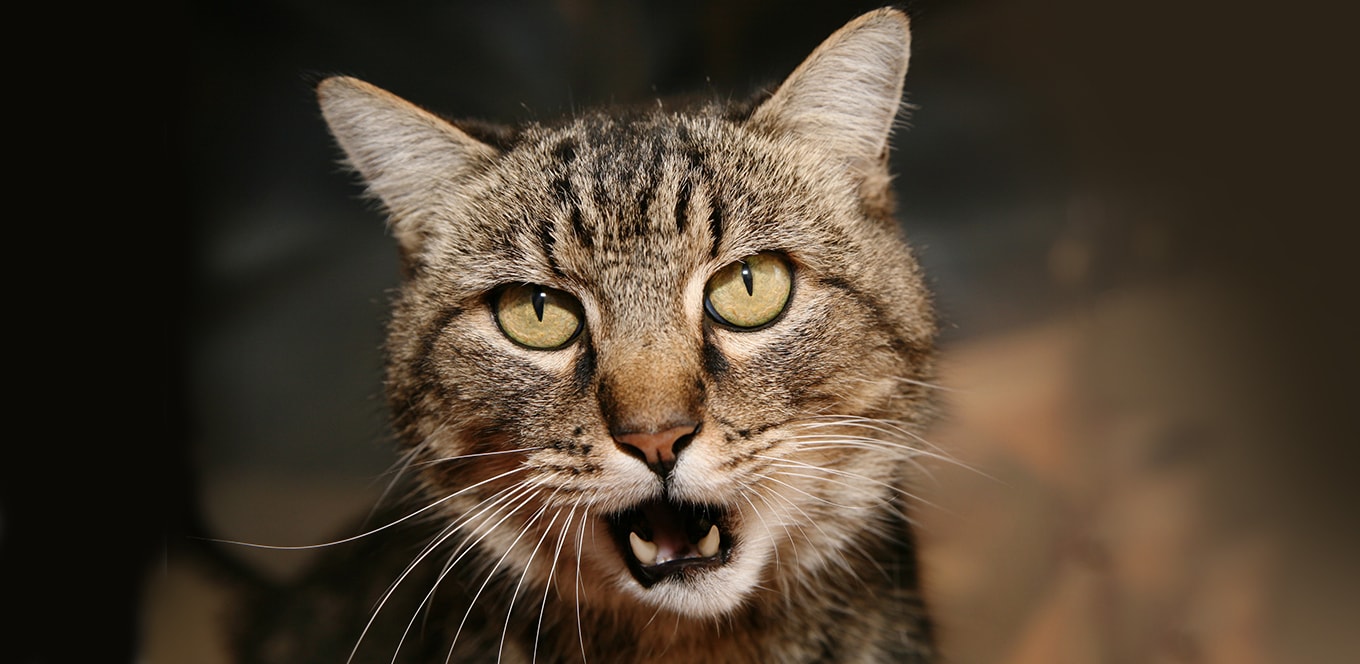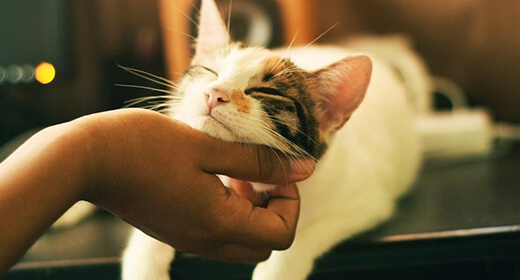

Listen up, Mom or Dad, because your feline definitely has something to say. Cats use more than 100 different vocal sounds to communicate. Here are nine of the most common sounds you’ll hear and what your cat’s unique language means.
While your cat’s purrs are usually a sign that they’re happy, comfortable or content, it’s important to point out that your cat might also purr when they are anxious, agitated or sick — because purring soothes them. The key to figuring out if it’s a “worry purr” is to check if their ears are folded back, if they seem tense or if they just aren’t acting normal. (If that’s the case, call the vet and grab the cat carrier.)
Why do cats meow? It’s simple: It’s their way of communicating with us!
Meows are your cat’s most common “word,” and every one means something different. For example, your cat might meow to greet you when you come home, to ask you to open your bedroom door so they can curl up on your pillow, or to say, “I’d like some more tasty kibble or a second serving of IAMS® PERFECT PORTIONS™ paté, s’il vous plaît.”
Chirps and trills are the loving language of cat mothers. Chirps, or chirrups, are staccato, bird-like sounds mother cats use to say to their kittens, “Follow me.” Trills are higher-pitched chirps your cat uses to say hello or “Pay attention to me.” When your cat directs these sounds at you, chances are they want you to give them some love or follow them somewhere, usually to their food or water bowl. (Shocker, LOL.)
If you have more than one feline fur baby, listen closely. You’ll likely hear your cats talk to each other with these sounds.
When your kitty spies an unsuspecting bird or squirrel frolicking outside the window, they might make a chattering sound at it. This distinctive, repetitive clicking noise is caused by a combination of lip smacking and your cat rapidly vibrating their lower jaw. This odd behavior looks like teeth chattering, and a lot of cats also chirp when they chatter.
This clickety sound is thought to be a mix of predatory excitement and frustration at not being able to get to the elusive feathered or furry prize. Some animal behaviorists even think the sound mimics a fatal bite used to break the bones of their prey. Who knew your li’l feline was so ferocious?!
Regardless of the exact reason cats chatter or chirp at birds and other small animals, most feline parents find it fascinating and amusing to watch.
The unmistakable sound of a cat hissing is like a steak hitting a hot skillet, and it can only mean one thing: Your cat feels threatened and will put up a fight if they have to. Just as important as the hissing sound, however, is the cat body language that comes with it. Your cat will flatten their ears, arch their back, puff their fur, twitch their tail and usually open their mouth to flash their fangs — aka the classic defensive pose.
In addition to a hiss, if your cat makes a deep, guttural growlsound, they’re saying, “Back off.” Similar to a dog’s growl, this noise means your cat is annoyed, scared or angry. Some cats even make short, higher-pitched snarl sounds before launching into a full-blown growl.
While these sounds usually signify an unhappy cat, it’s important to note that some cats growl because they’re in pain from an injury or a health problem. If you suspect this is the case, a trip to the vet is in order.
If your feline snarls or growls at you for any reason, though, it’s best to leave your feisty friend alone.
A yowl, or howl, is a long, drawn-out meow that almost sounds like moaning; it’s your cat’s way of telling you they’re worried or distressed, or that they need you. They might have gotten locked in a closet, can’t find you anywhere or, heaven forbid, have discovered their food bowl is empty. Your cat might also yowl when they don’t feel well or when a new neighborhood cat trespasses on their turf.
Whatever the reason, make sure you immediately help your cat whenever you hear a yowl. Trust us — you’ll both be glad you did.



Cats are known to be solitary creatures and enjoy spending time with themselves. However, as a pet parent, you must ensure that your cat remains healthy. It is advisable to keep an eye on your cat’s behaviour to detect a sudden change, even what it eats, and in how much quantity. A regular health checkup is one of the most basic yet essential steps to a cat care guide. Taking care of cats is comparatively easier than taking care of kittens. A diligently followed routine for cat care can also be quite helpful.
Medical care: Adult cats should be taken to the vet for a complete checkup at least once a year. This will ensure that your cat is in good health and will also catch any disease symptom overlooked by you.
Hygiene: Cats usually lick and clean themselves, but it is always advisable to bathe your cat every 4-6 weeks. Their crates should also be cleaned regularly to make sure they do not fall sick.
Feeding: Till the time your kitten is four months old, it can be fed three times a day. Post four months, you can begin the transition to feeding it twice a day. It is still advisable to consult a vet before deciding the frequency of the meals.
Dental care: Your cat’s dental care is just as important as yours. It is advisable to set a dental care routine right from its kitten phase. You can dip your gloved finger in a little toothpaste made for cats in its mouth to clean their teeth and gums. If your cat’s mouth smells bad, it may be an indication of a disease. So, book an appointment with your vet without any delay.
Socialising: You can get your cat to socialise too, but you have to keep a few things in mind. You may get down to its level to initiate contact and speak in a calm voice. You may also pat its head to let it get familiarised with your touch.
Now that you have brought your cat home, the next step is to comfortably settle it in your house. Housetraining might sound like a tedious task but it isn’t. With a little practise and lots of patience, you can easily housetrain your cat. Some of the most basic things to keep in mind while housetraining your cat include providing a proper litter box, spaying your cat, toilet training and cat proofing the house. Given below are some tips that may help you easily housetrain your cat:
Litter box: It is advisable to place the litter box in an easily accessible location. You should avoid moving the litter box unless necessary. And even if you have to move it, shift it a few inches every day. Also, keep in mind that your cat will not use a dirty or smelly litter box. Hence, scoop out the solid waste at least once a day and clean it using mild detergents.
Cat-proofing: It is important that you keep harmful things out of reach from your cat. First and foremost, tie up all loose cables and wires so that your cat won’t get tangled in them. Make sure candles and other flaming substances are kept at an unobtainable distance from the cat. If you use essential oils frequently, make sure your cats do not come in contact with them either, because certain ingredients in these oils may be toxic for your feline friend.
Spaying: Spaying your cat has several health benefits and ensures your cat lives a healthy life. You may fix an appointment to spay your kitten when it is as young as eight weeks old. If you have a cat, it is advisable to get it spayed before it reaches five months of age.
Toilet training: This is one of the major concerns of all cat parents. Here’s how you can toilet-train your cat with a few simple steps –
1) Place the cat’s litter box closer to the washroom.
2) Raise the height of the litter box a little every day.
3) Slowly, transition your cat to use the actual washroom every time it wants to go.
4) Give your cat a treat each time it uses the washroom. This will encourage good behaviour.
Taking care of your cat’s health comes first in the cat care guide. Even though cats lick and self-groom themselves, they cannot get better on their own if they contract the following diseases:
Vomiting: This is one of the most common health issues in cats and is caused by various factors. Hairballs, eating something inedible, or a urinary tract infection are some of the reasons why your cat may be vomiting.
Feline Lower Urinary Tract Diseases (FLUTD): Both male and female cats can contract FLUTD and its main cause is obesity or only eating dry food. Some of the symptoms of FLUTD are bloody urine, crying while urinating, straining to pee, licking around the urinary area due to pain, dehydration and vomiting.
Diarrhoea: Cancer, infection, allergy and bad food can be the causes of diarrhoea. It is advisable to give your cat a lot of fresh water to drink if it has diarrhoea.
Tapeworms: Tapeworms can cause extreme discomfort to your cat as they reside in its intestines. You can spot tapeworms with your naked eye in your cat’s stools. The symptoms of worms are vomiting and weight loss.
Feline Immunodeficiency Virus (FIV): This virus can make the immune cells attack the white blood cells in the cat’s body. This gradually weakens the cat’s immune system. FIV’s symptoms are poor coat condition, persistent diarrhoea, seizures, eye problems, lack of appetite, and recurring fever.
If you notice unaccountable minor changes in your cat, then it is advisable to rush to the vet to rule out any of the above-mentioned diseases and seek proper treatment on time.
‘How to take care of a cat’ is a question asked by many first-time cat owners, as cats can be difficult to figure out. But with a few careful steps, you can easily take care of your cat. Here are some cat care tips for first-time cat owners:
Cats are not easily adaptive to change. So, when you bring your cat home for the first time, you need to help it familiarise with the new surroundings by setting up its own space in the house. You can also add a cheery vibe to its crate by adding toys and a blanket.
Find a vet you can visit for your cat’s timely checkups. It is not advisable to ignore even the smallest recognised change in its health, and it is better to get it checked by the vet.
Cats love quality playtime as well. We recommend you get adorable toys for your feline friend to play with. You, too, can bond with your cat during this time.
Give it time to adapt to its new surroundings and the new people around them.
Ensure you buy healthy cat food for your new friend in advance and set a timetable for its meals.